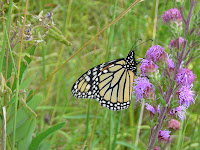This morning I came in to work and saw the butterfly still hanging from it's chrysalis. It was in the 50s this morning which is a bit too chilly for an insect to be moving about with ease. So I carefully placed the butterfly in a bug box and placed it on the table closest to the fireplace. I just wanted it to warm up after a chilly night in the Shelter.
Monarchs are truly amazing. Well, all butterflies are really. Think about this: they start their lives as tiny caterpillars hatched out of a tiny white egg. Their first meal? Their egg! What next? The milkweed leaves the egg was deposited on. They eat and eat and grow and grow shedding their skin several times. The milkweed leaves they eat are slightly toxic but they are immune. Anything that eats them makes the predator sick (birds throw up if they eat a monarch). Predators learn not to eat these guys.
Then something amazing happens! They begin to wander - go for "walkies". They find a leaf and hang themselves upside down in the "J" shape. They molt their skin one more time and form a delicate green chysalis with tiny gold dots around the edge. Beautiful!!! And they remain in that form for 10 to 14 days. During that time, they completely rearrange themselves! The caterpillar is no longer a caterpillar. It takes its caterpillar parts and assembles a completely new creature! After 10 to 14 days, the green chysalis becomes clear and one can see that inside is something that is black and orange. A butterfly is inside!!! Suddenly the chrysalis breaks open and this incredible new being emerges and spreads its wings for the time! Truly amazing!
Check out this video I took a while ago of a monarch caterpillar in J-shape and a monarch butterfly emerging!
Around noon today I brought the newly emerged butterfly up to the prairie. It was still overcast and still a little cool. I was hoping it would be warmer up there on the hill and that the little insect would quickly find the flowers and food it needed to survive. I was worried about this one. It was lathargic and still, only flapping it wings every once in a while. I opened the container and let the butterfly crawl onto my warm finger. It stayed there, clinging to my fingertip. It opened and closed its wings a few times and I was hopeful it would take off. It didn't. Soon I moved over to the edge of the clearing under the oak tree and placed the butterfly on a flower. It reluctantly and awkwardly left my finger and gripped the tiny white flowers. Hmmm...

I was concerned, yes, but understood. The weather has changed dramatically in the last two weeks. At the end of August it was hot, humid and sunny. Suddenly September arrived and so did autumn. And this week the temperatures have not gotten above 70 and we shouldn't expect to see those days again this year. One of the factors that trigger migration not only for monarch butterflies but for birds and other migrators (including dragonflies!) is temperature. Another is the length of day. Now as 7pm approaches dusk is upon us and the day is ending. In the morning the sky does not lighten until nearly 7am. Next week is the equinox and then we will begin to have less than 12 hours of daylight until March. And now the blooms of our flowers are nearly all done and the plants are beginning to senesce. Living things see and feel these changes and know that autumn is here and winter is not far behind. The leaves have already begun to change and fall is here in the Twin Cities. It's time for creatures to migrate or stock up on supplies or get ready to hibernate. They know.
If this monarch I released today survives, it will fly to Mexico. MEXICO!! 3,000 miles!!! What an incredible journey! Flying over prairies, lakes, rivers, and deserts to Mexico. Amazing! You can follow their journey by visiting Journey North From this page you can follow not only monarchs but other migrating animals too. Check back in the spring to find out when they will be returning to your state. And then you will get another season to enjoy the monarchs! The monarch who make here in the spring are actually the 3rd or 4th generation from the original butterflies who flew down to Mexico.



So how do they know where to go? They may use the Earth's magnetic fields or the position of the Sun or both or other factors. Who knows? No one really. Once thye arrive in Mexico, they live in the mountains high above sea level. They cluster together for warmth and use the humid air to stay moist. Unfortunately, there is significant habitat loss not only in Mexico but here in the United States as well. Monarchs have fewer places to find food, lay eggs, and overwinter. There are organzations out there doing their part to raise money and awareness to the plight of the monarchs (the Minneapolis Park and Recreation Board has a Monarch Festival in September). And just raising monarch caterpillars is a fun, rewarding way to help the population along. Those little caterpillars will be protected from predators while they are young in your care and hopefully will make it to maturity to lay some eggs and perhaps migrate to Mexico!
I'm not sure if my monarch flew off today. I'd like to think he did. I'd like to think that the little orange and black miracle found some flowers, powered up and took off in a southerly direction. Or at least became nourishing food for a bird...
For more information on monarchs, their migration and more check out: http://www.fs.fed.us/monarchbutterfly/migration/index.shtml
No comments:
Post a Comment